Expedition Log: BIOT – Day 6
A species is said to be endemic if it is confined to a defined region like an island, country or geographical zone. As we move our research from the West Pacific to the Indian Ocean here in the Chagos Archipelago we have started to see some new species of fishes, corals, and invertebrates. Conversely, many that we were used to seeing on previous missions are notably absent in our present location. This shift in the faunal composition of the reefs is expected as we have covered a great distance on this latest leg of the Global Reef Expedition.
While doing research to learn about the Chagos Archipelago before this mission, I noticed that there was an endemic species of coral that occurs here—Ctenella chagius (obviously named for the location of its discovery). During the first couple of days of diving I was keeping my eyes peeled for this novelty but wasn’t noticing it. Back on board the Shadow one evening, I did an image search for this species so that I would have a search image in mind while diving. There are remarkably few photos of this species available online but I located enough to get a general idea of the size and form of the colonies. During the next day’s dives I thought I spotted a small, fragmented colony that had the correct “brain coral” texture but the ridges were smaller than I was expecting. Over the next few days Samantha Clements, one of the scientists doing benthic surveys, reported seeing colonies. We compared notes and after matching our initial photos of the colonies to the few pictures online and in our coral identification reference book, we were certain that what we were seeing was the endemic Ctenella coral.


Smaller spherical Ctenella colony showing the pale brown and cream coloration commonly seen. (left) / Larger colony approximately 50 cm across. (right)
(click-thru on images for greater detail)
What makes this coral even more interesting is that it is something of an oddity. Some endemic species belong to a genus with several other species and the endemic form is very similar to its kin that are found elsewhere. Ctenella is a monotypic genus (containing a single species) in the family Meandrinidae. One online taxonomic database listed a second species (Ctenella aurantia) which I researched to see if it resembled C. chagius. What I found is that this second species was a ctenophore—an organism in a totally different phylum! It is unusual for two taxonomically unrelated organisms to share the same genus name but occasionally it does happen. This also points out the limitations of relying too much on a single online source without corroborating research.
Corals in the family Meandrinidae are typified by having meandering valleys that run for many centimeters containing evenly spaced corallites. The ridges separating the valleys are composed of septa (thin plates) that run perpendicular to the valleys. The septa are not fused together at the top of the ridge but instead form an alternating zipper-like pattern. In the daytime, small tentacles are usually visible between the septa along the ridges as well as in the valleys. Ctenella is the only member of the Meandrinidae found in the Indo-Pacific—a family more common and diverse in the Tropical Western Atlantic—and it probably represents a relict population here in Chagos.
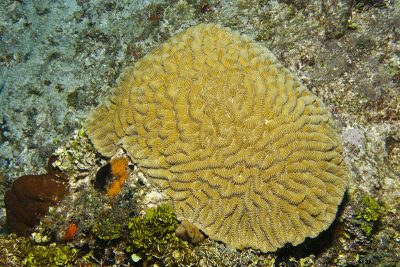
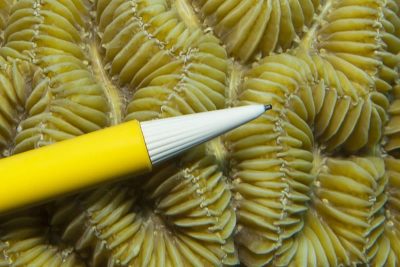
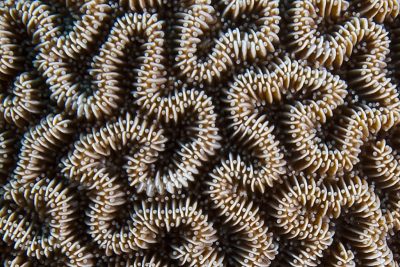
Similar looking Meandrinidae coral species from the Caribbean—Maze Coral (Meandrina meandrites). (left) / Detail of the Caribbean M. meandrites showing the alternating septa which are not fused along the midline of the ridge (pencil for scale). (middle) / Detail of Ctenella chagius showing meandering structure and alternating septa with tentacles visible between. (right)
(click-thru on images for greater detail)
Ctenella chagius is an aggressive coral which can extend digestive filaments from its stomach onto the living tissue of neighboring colonies destroying it. This process is known as extracoelenteric digestion and can help a coral compete for light and space on very competitive reef systems.
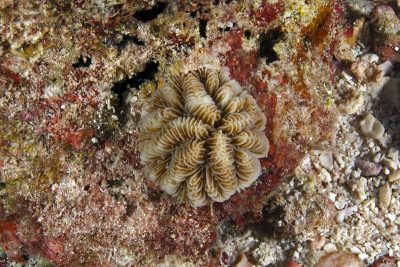
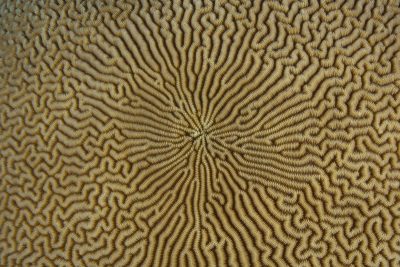
In addition to the many medium and large size colonies, we occasionally spotted small Ctenella recruits getting their start on the reef. (left) / Interesting pattern of valleys and ridges that radiate out from a single point on this larger colony. (right)
(click-thru on images for greater detail)
During our survey dives whenever I come across a Ctenella colony, I pay a little extra attention to it as I know I won’t be seeing this species once we’ve completed our survey of the Chagos Archipelago.
Photos by Ken Marks.


